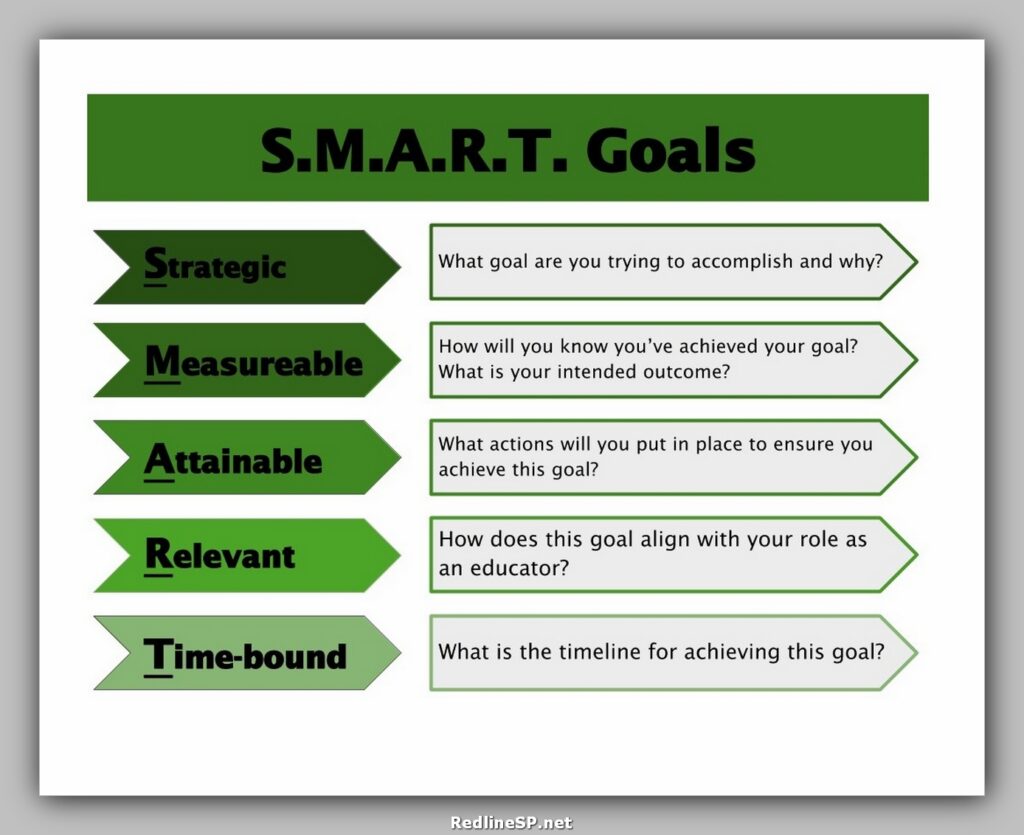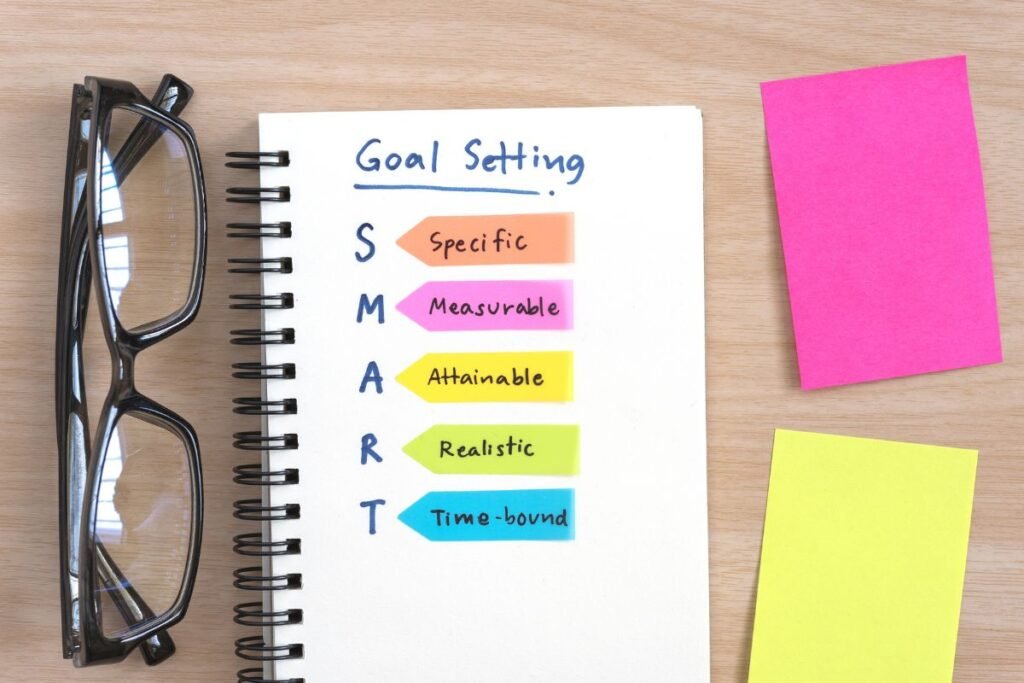Did you know that setting the right academic goals is one of the keys to making sustainable progress? In one study, 69 percent of the students who set SMART goals achieved notable progress. In comparison, such progress occurred for 60 percent of students before the implementation of goal setting.
Setting goals is important for everyone, but it is especially critical for students. Smart goals keep students focused, motivated and on track to achieve success. This article will provide 9 smart goal examples to help students of all ages succeed in school and life.
What Are SMART Goals?
SMART is an acronym that stands for specific measurable achievable, relevant and time-bound. SMART goals are purposefully designed to provide structure, organization and a clear path to achieve your aims. This methodology has been proven to increase the likelihood of accomplishing goals.
There are a few key elements that make up a SMART goal
-
Specific: The goal should identify a specific action or outcome.
-
Measurable: You should include quantifiable criteria to track your progress.
-
Achievable: The goal needs to be realistic and attainable for you.
-
Relevant: The goal should align with other overarching objectives.
-
Time-bound Include specific target dates to complete the goal
Well-formulated SMART goals will propel you forward and support you on your journey toward success. Let’s look at 9 SMART goal examples that can help students excel.
9 SMART Goal Examples for Students
Here are 9 SMART goals to help students of all ages excel in academics and life:
1. Improve Academic Performance
I will improve my math grade from a B+ to an A- by the end of the semester by attending tutoring twice a week and completing all assignments one day before they are due.
2. Improve Organization
I will develop better organizational skills by cleaning out and organizing my backpack every Friday after school this semester so I no longer lose assignments and papers.
3. Increase Class Participation
I will increase my class participation this quarter by raising my hand to answer a question at least 3 times per class period in each of my classes.
4. Learn Another Language
I will become proficient in Spanish by dedicating 30 minutes per day to Duolingo lessons with a goal of reaching the advanced level by the end of this school year.
5. Improve Academic Performance
I will improve my science grade from a C to a B this quarter by reviewing my notes for 20 minutes every night and meeting with my teacher twice a month to review any concepts I am struggling with.
6. Improve Reading Level
I will improve my reading fluency from a 3rd grade level to a 5th grade level by the end of the school year by reading an additional 20 minutes per day. I will track my progress with monthly reading comprehension assessments.
7. Increase the Amount of Sleep
I will improve my daily productivity and alertness by ensuring I get 8-9 hours of sleep each night. I will log my bedtime for the next month to monitor my progress.
8. Improve My Productivity
I will complete my homework and study for tests 3 days prior to due dates this semester so I have ample review time. I will create a weekly study schedule to ensure I meet this goal.
9. Learn A New Skill
I will learn to play acoustic guitar by dedicating 30 minutes per day to practice and lessons. I will learn 5 songs fluently and perform one by the winter recital this year.
The Benefits of SMART Goals for Students
There are many reasons why setting SMART goals is highly beneficial for students including:
-
Creates a clear plan and structure.
-
Improves organization and time management skills.
-
Provides measurable progress and milestones.
-
Increases motivation and self-confidence.
-
Teaches the goal-setting process for lifelong learning.
-
Helps students stay focused and on track.
-
Allows students to take ownership of their learning.
-
Sets students up for current and future success.
No matter what goals students want to accomplish, using the SMART goal framework provides the blueprint to make it happen. While academics are important, SMART goals can also be utilized in extracurricular activities, relationships, health and more. Encourage students to apply this technique to set targets in every area of life.
Tips for Students on Setting SMART Goals
Here are some helpful tips for students when developing SMART goals:
-
Involve parents and teachers in the goal-setting process for guidance and support.
-
Set specific, quantifiable criteria to accurately track progress.
-
Make goals challenging but attainable based on your level and resources.
-
Align goals under common themes like improving academics or developing skills.
-
Set a variety of short and long-term goals; break long-term goals into milestones.
-
Write goals down and post them where you will see them daily.
-
Re-evaluate goals periodically and adjust timelines or criteria as needed.
-
Reward yourself when you achieve your aims.
-
Learn from setbacks; modify goals as required and keep going.
With some planning, effort and persistence, SMART goals provide students of all ages with a proven strategy to accomplish their dreams. Use these examples and tips to set targets and watch your students thrive!

SMART Goals Examples for Academic Success
Now that you understand how SMART goals apply to broader objectives, let’s examine a couple of realistic examples related to academic success.
- Improving grades: Set a very specific goal like getting an A on your next biology exam. The goal is SMART because:
- S: You have a specific goal that relates to a particular academic discipline and an upcoming event (your next test).
- M: The measurement you’re going to use is the grade you’ll get.
- A: The goal is attainable, for example, because you had an A- in your previous biology exam. You know that you can get there.
- R: Very relevant for the long-term goal of graduating with honors. It will impact your report card, which is considered an important measure of academic accomplishment.
- T: There’s a very realistic time frame for achieving the goal because the next biology exam is in 10 days.
- Completing all homework on time:
- S: You will be asked to turn in your homework on a certain date, meaning you have a specific outcome to accomplish before that.
- M: Success will be measured by your ability to turn in all homework on time.
- A: The goal is achievable because you’ve given up on a few parties this week to dedicate enough time to homework completion.
- R: As a form of performance evaluation, homework is very relevant to maintaining a good academic track record.
- T: The time period you have for homework completion is very specific and non-negotiable.
- Memorize 100 French language flashcards in two weeks:
- S: The goal is very specific as it pertains to learning a new language.
- M: As far as SMART criteria go, the goal is measurable because a friend will easily test you and provide feedback on your progress.
- A: This goal is achievable because you have a proclivity for language learning and your vocabulary is already extensive enough.
- R: Achieving this goal will help you excel in French class and also give you an important skill you can use in the future.
- T: You have set a very specific timeframe for the completion of the goal that’s based on your skills and upcoming French class tests.
These are just a few examples of very specific and academic SMART goals. Other relevant goals could include participating in class more often, studying for an hour per day each day after school, improving research skills, and maintaining a study journal.
Discover 10 Essential Study Skills to Improve Your Learning Strategy.

What Are SMART Goals?
SMART is an acronym that stands for:
The Corporate Finance Institute reports that SMART goals speed up the journey toward success by helping you determine the right priorities and pursue those most consistently. The framework breaks down larger projects into SMART objectives and employs concrete criteria to measure success.
With the SMART method, a student has a very specific idea of what needs to be accomplished and how to get there. Furthermore, progress becomes easy to track. The SMART goal framework allows you to come up with a precise time frame for the completion of a project. It also enables the setting of very specific targets or milestones, aimed at encouraging you and showing you just how much progress you’ve made.

15 SMART Goals Examples for Students [NEW FOR 2023]
FAQ
What are SMART goals for ELA?
What is an example of a SMART goal for special education students?
What is a SMART goal for a child?
What are smart student goals?
SMART student goals are targets for your academic career and student life that are specific, measurable, achievable, relevant and time-bound. The following is a summary of the SMART criteria followed by various examples for students. The goal identifies a specific action you will take and outcome you will achieve.
How do you set a smart goal?
For the SMART framework, a student should set one goal that meets five clear criteria. The goal should be: Specific – Be clear about exactly what the goal is and what will be done to achieve it. Consider giving details about what, when, where, why, and how. Measurable – Make sure you have a way to assess whether you have achieved your goal.
What are some examples of SMART goals?
Other examples of SMART goals in this category: Example: Stay in touch with high school friends by hosting a Zoom hangout once every two weeks This goal is specific: You have a who (your high school friends), a what (virtual hangout), a when (every two weeks) and a where (over Zoom).
Why should you use SMART goals?
Using the SMART system when goal setting helps you accomplish so many things: If you want to be a better student, get good grades, find extracurriculars that truly enrich your college experience—you name it—SMART goals can give you the framework you need to make these things happen.